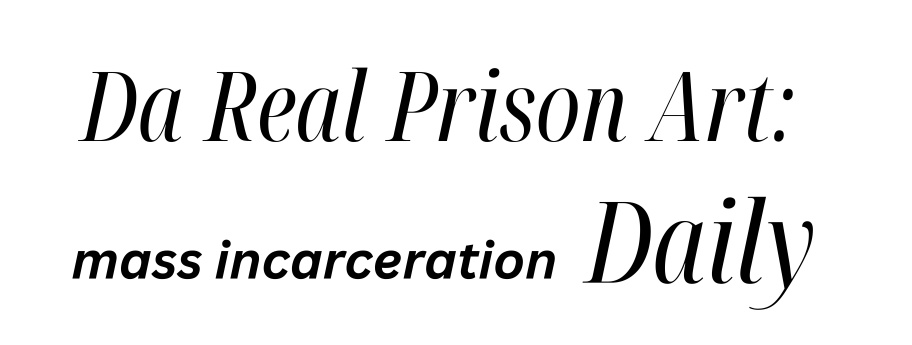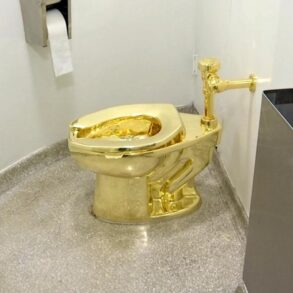Read more about this story and why we reported it here.
The underground art of prison tattoos has gone mainstream at Delaware’s largest lockup.
In recent weeks, men imprisoned at James T. Vaughn Correctional Center near Smyrna began inking the flesh of their fellow prisoners in the open as part of a new education program organized by officials at the prison.
Any prisoner will tell you that tattoo art is a longstanding and prevalent part of culture behind bars. But unsanctioned ink brings the risk of segregation and other punishments as the components of underground tattoo art − things like sharpened staples, retrofitted VCR motors and ink derived from the soot created by tiny fires – are regarded as dangerous contraband by prison officials.
The new program essentially allows a group of imprisoned artists to operate a tattoo studio within the prison with their fellow prisoners as their customers.
Prison officials say bringing tattoo art into an educational, organized and clean environment is meant to give men in lockup a safe outlet to express their individualism and provide groups of prisoner artists cycling through the program the chance to build the foundation for a career outside the walls.
In a state where more than half of prisoners that are released return to lockup within three years, elected officials have long promised to address that societal failure by making modern prison more about rehabilitation than punishment. People in prison say programs like the new tattoo education project are among the building blocks of bringing that popular talking point closer to reality.

Imagine spending pretty much your entire adult life locked away and then being turned out into the rat race of modern society and expected to make a living. That’s what Sam Coppola, an artist in the program, is looking at two years from now.

He worked in construction before he was locked up as a much younger man. He gravitated to unsanctioned tattoos when he was first imprisoned because he knew how to draw and it was a “great hustle.”
Coppola explained how the program has changed his outlook on his future release as he inked the wings of an angel onto the forearm of another person in prison.
“I’m almost 60. I can’t build houses anymore. I’ve been locked up for going on 30 years. I don’t really have anything,” he said. “I figure this is a great opportunity. It has given me a positive outlook on something I can leave for my kids and grandkids as well.”
‘I don’t feel like I’m in prison’
A door with a bright blue sign that reads “James T. Vaughn Tattoo Studio” sticks out from the seemingly monotone and treeless landscape of chain link and razor wire lining Vaughn’s compound.
Inside, the only obvious signs that one remains in prison are the artists’ state-issued white uniforms and security staff looking on. The tattoo studio is in a retrofitted, long-vacant chow hall. The space has a chill, industrial vibe with music from a lo-fi YouTube channel streaming into the room.
There are several booths with professional equipment for the artists to work with, as well as space for teaching.
Joshua Lucas, an artist in the program, reminisced about how he and others used to talk about the potential benefit of this once-empty space for prisoners. He said he never thought he’d actually be inking his friend inside the building.
“I don’t even feel like I’m in prison,” Lucas said. “I just feel like I am blessed to be here.”
He searched for the right word to describe those feelings as he touched up lettering on the neck of Luis Cruz, a friend he knew from Wilmington well before they were both locked up. They joked about the old days of using sharpened staples and other refitted tools to tattoo each other behind bars and discussed their aspirations outside the prison walls.

They described the time together as an “honor and a privilege.”
Six men comprise the program’s first class of artists. They were chosen by prison leadership based on their history of good behavior inside, their artistic ability and their trajectory toward freedom.
The artists in the program typically work 40-hour weeks in the studio. Andre Peters is one of those artists.
“It is an escape,” Peters said. “It takes you out of (the prison).”
Other prisoners that come into the studio to consult for a future piece “get the vibe” and don’t want to leave, he said with a laugh.
The monotony of prison can saddle people locked up with a lot of downtime. Peters said this work gives him purpose. When work is over, he showers, maybe talks to his family and the day is over. He now spends his weekends waiting for the next workday and thinking about the future.
“I am not locked up right now,” he said standing in the studio. “You have to find a way to free yourself.”
How the program works
That’s by design, said Larry Normile, the program’s instructor. He said he has tried to create an environment where the men “can feel like you are not still being judged by your past but being rewarded for your future and talents.”
Normile owns Artistic Additions tattoo studio in Dover, is a veteran of the industry and has been hired to work part-time inside the prison as the program’s instructor. In his younger days, he also spent time in each of Delaware’s lockups before he got into the industry.
It gives him perspective, Normile said, adding that he wants to give the men a “roadmap for success,” similar to the one he followed to become the person he is today. That goes beyond creating a vibe.
The program’s first 12 weeks are spent in an educational setting, learning artistic fundamentals like line work, design and shading. The artists also study sanitation protocols and bloodborne pathogens, as well as the basic supplies and equipment used in the modern industry.
From there, they graduate to inking fake skin, spending another 12 weeks mastering modern techniques with an emphasis on hand positioning and needle control.
Recent: Internet-enabled tablets now available to all Delaware prisoners: The promise and costs
And in December, they moved to the final phase of the program: inking their fellow prisoners. And while the program is limited to Vaughn, it has been the talk of prisoners statewide.
Major Randall Dotson, the top security official at Vaughn, said there are hundreds of prisoners who have applied to get inked through the program. Applicants have a consultation with one of the prison artists and the design is reviewed by prison officials before ink is put to flesh.

The artists receive half of the proceeds from each tattoo. The other half goes into the program to pay for supplies, insurance and other costs. Once the revenue covers the cost of running the program, the proceeds going to the prisoners will jump to 60 percent. They also contribute five percent to a nonprofit of the artists’ choice, Normile said.
The artists inside see the immediate earning potential as a boost to their chances of success on the outside.
Prisons largely function on prisoner labor, but Delaware prisoners with institutional jobs are paid an average of 28 cents per hour. Through their commissions, artists involved in the program can easily earn a months-worth of prison wages in a day.
It has Lucas thinking about saving for housing and transportation and building his credit score when he is released.

“My goal is to save so I can hit the ground running,” he said.
‘It’s a rush’
Part of the reason the program has so many applicants for ink is the popularity of unsanctioned tattoos behind bars, even though the clandestine process brings serious risks of institutional punishment and health issues.
D’Andre Rogers, who is currently at Sussex Correctional Institution, has been locked up for a bit more than 15 years. He’s spent part of his time as an underground tattoo artist and has the disciplinary write-ups to show for it.
He said tattoo culture is something that spans ethnicities, backgrounds and individual personalities in prison.
“It’s like one of the first things people start thinking about when they come to prison,” Rogers said.
Prisoners say there are many reasons for that. Rogers noted there isn’t a lot going on in prison, so the departure from monotony is a “rush.” Actually applying the ink is a fun challenge and can be soothing, he said, adding it took him five or six years to get “good good.”
“We like competing with what we see outside and can make our work better than theirs,” Rogers said.
Some prisoners see getting inked as a badge of honor, like earning your prison stripes, Rogers said. Some have seen it as a less expensive alternative to tattoos on the street, he added. Prison also strips a person of individualism in some ways, so ink is a way to express oneself, Lucas said.
And while there are numerous longstanding stereotypes about prison pieces, Rogers said the pieces often defy those stereotypes.

“It ain’t your mom and pop tattoos you got 20 or 30 years ago,” Rogers said.
Common themes are those that honor or remember loved ones or past life outside the prison walls, said Sakana Walls, an artist who tattooed himself and others behind bars before his release from prison last year.
“When you come to jail, you think about whose lives you’ve messed up and you want to honor them,” Walls said.
READ HIS FULL STORY: Finding art, purpose and dignity inside Delaware’s largest prison
Some people are drawn to tattoo by seeing others with an elaborate, fresh piece. Others are fascinated by the process, which requires some ingenuity and sly.
It starts with ink.
Ink is made by burning something, typically hair grease, baby oil or a wad of tissues in an enclosed space like the cartridge of an asthma inhaler. The burn is positioned so the smoke runs along a piece of metal that collects soot, Rogers explained.
The soot is scraped and collected in a makeshift vial and mixed with water and sometimes shampoo to create the ink.
The needle can be crafted from many things, from guitar strings to staples. But the ideal needle is the spring on an ink pen. It can be straightened, cut into sections and sharpened for multiple needles.
Then there is the motor. Old VCRs and electric shavers have been commonly repurposed into motors, prisoners said.
All of these components are MacGyvered together with something like a bent toothbrush as a handle. Prisoners can connect the electric component to a wall outlet, but Rogers said he likes to fashion a handheld battery pack for ease of handling.
“I’ve done turned into an electrician in here,” Rogers said. “A chemist too.”
Getting caught in the act with this repurposed material can land a Delaware prisoner with a class one writeup, the most serious in the state system. That often results in the prisoner being moved to more segregated disciplinary housing, known as the hole, the loss of daily privileges, prison jobs and good time.
So prisoners will sometimes hire a lookout for a few dollars or a bag of coffee to alert the tattoo artist when officers are coming onto the tier.
Dotson, the security official, said the infraction is taken seriously. Officials might photograph prisoners’ new ink for their security database and use video footage to try to investigate the source and search that area.
“But we can’t be everywhere all of the time,” Dotson said.
‘A positive outlook’
Health concerns and the corresponding cost for medical treatment risked by inking tattoos in uncontrolled and potentially unsanitary conditions are among the reasons prison officials began the education program, Dotson said.
It’s also about giving the students involved a leg up on reentry into society, said Normile, the program’s instructor.
Peters, one of the artists in the new program, has been locked up by Delaware for 15 years. He spent a number of those years in the prison’s automotive program and said that was his job trajectory upon release.

But he’s an artist at heart.
“I have this thing in my mind: I have to find a way to do what I love and find a way to live off of it,” Peters said.
That’s a freedom that most people in the outside world don’t ever see in their lives. And for Peters, that’s the potential of this program.
“I always had a passion for art, but I didn’t know how to translate that into a career,” he said. “This gave me something to look forward to and it teaches you how to do it the right way.”
Normile has big plans for each of the men and equally big aspirations for the program itself. The students will leave the program with more know-how than many tattoo artists, a portfolio of work, and his guidance and endorsement in getting a job in the industry.
Normile said he’s been most impressed by the artwork, saying that prison is full of “hidden talent.”
“I believe everyone (in the program) could be on the street right now, making money,” Normile said. “With the right resources around them, they’d be fine.”
As part of that, he is organizing education around their finances and intends to get involved in their post-release probation supervision. He also has big intentions for bringing the program to the other prisons in the state, evolving it to include tattoo removal services and building other programs alongside the tattoo program.
Underpinning this intent is the idea that a prison that just locks people up and treats them like “animals” is doomed to fail those they imprison and society at large.

“These are people,” Normile said. “They have done something, they can’t take it back, they regret what they have done, but they are also human beings that deserve a second chance as well all do.”
Speaking on his 15 years locked up, Peters said he felt there hasn’t been a lot of programming options for prisoners, describing the environment as “stagnant.” But he sees things changing.
“Something like this changes the whole morale,” Peters said. “You walk around, and this is all people are talking about.”
Contact Xerxes Wilson at (302) 324-2787 or xwilson@delawareonline.com. Delaware prisoners may also contact Xerxes Wilson on the GettingOut app.
We reported this story because the new program is a novel approach to promoting rehabilitation in the prison and building individuals up to be successful once they exit lockup – a fundamental promise made by those who oversee modern prisons. The reporting also provides readers a rare look inside the prison itself as well as into the minds of men who are locked up and preparing to return to society.
Readers will notice that the photographs accompanying that story do not depict the artists’ faces. Prison officials allowed rare media access inside Vaughn for this story. Upon arrival at the facility, the photographer was barred from photographing the prisoners’ faces and conducted the assignment under those conditions. Officials also sought to suppress the last names of those artists. Their motivation is to avoid inflaming the victims of the crimes that put the artists in prison. This reporter ultimately objected to both conditions. This story includes the identities of the artists and links to social media accounts depicting their art where possible. The newspaper was not allowed back into the prison to photograph the artists’ faces.
This post was originally published on this site be sure to check out more of their content.








